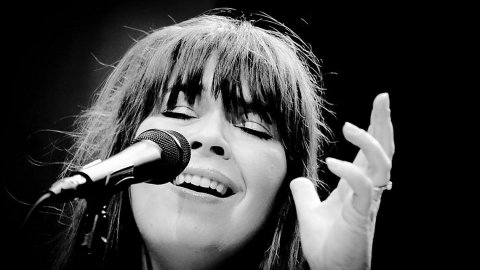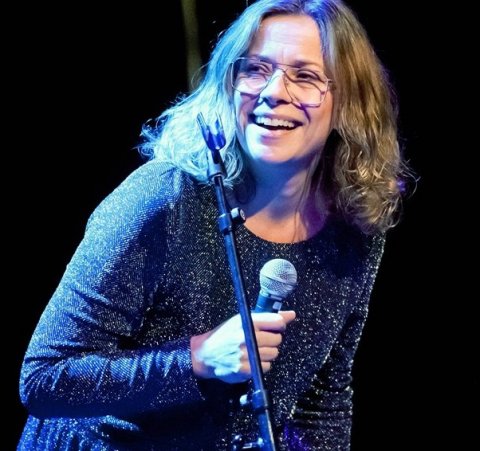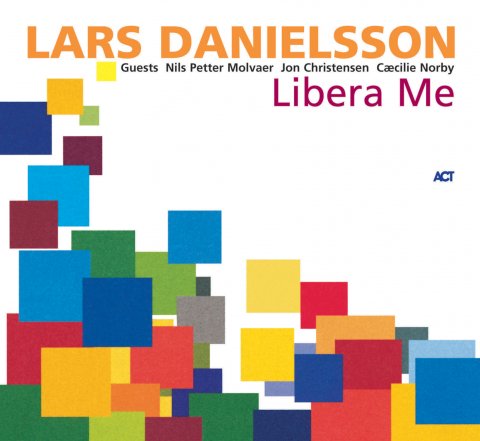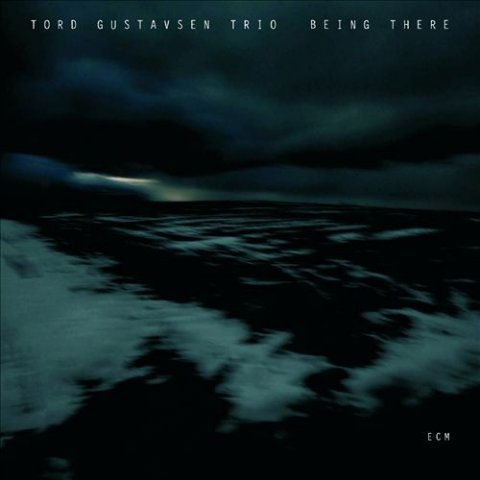________________________________________________________________
Solveig Slettahjell

Solveig Slettahjell is an award-winning Norwegian jazz singer who made her album debut in 2001 and generally performs with her Slow Motion Quintet. Born on April 2, 1971, in Bærum, Norway, she studied at the Norwegian Academy of Music. Upon signing a recording deal with the Curling Legs label, she made her solo album debut in 2001 with Slow Motion Orchestra. Recorded live in concert on May 22, 2001, in Oslo, the album is titled after her band (later renamed the Slow Motion Quintet), which was originally comprised of Morten Qvenild (piano), Sjur Miljeteig (trumpet), Mats Eilertsen (bass), and Per Oddvar Johansen (drums). Like her full-length debut, the follow-up album Silver (2004) was an English-language effort comprised of jazz standards as well as original material. It was a breakout album for Slettahjell, earning a Spellemannsprisen Award in 2005 for Jazz Album of the Year and reaching number 23 on the Norwegian albums chart. Her third album, Pixiedust (2005), capitalized on the critical success, charting at number 15 in its first week of sales. Following another similarly styled album, Good Rain (2006), which marked a slight decline in her popularity, Slettahjell took a different approach for her next full-length effort, Domestic Songs (2007). The first of her albums not to feature the Slow Motion Quintet, Domestic Songs features Slettahjell herself on piano and was recorded at home during a ten-day period in February 2007. With the exception of a few covers, the material is comprised of originals written by Slettahjell, Miljeteig, and Peder Kjellsby. Slettahjell continued to take a different approach with her next full-length effort, Natt i Betlehem (2008), a Christmas album recorded in a church in Bethlehem between September 29 and October 2, 2008. A spare Norwegian-language recording featuring the trio of Slettahjell (vocals), Miljeteig (trumpet), and Tord Gustavsen (piano), Natt i Betlehem was her best-selling album to date, reaching the Top Five.
_____________________________________________________________________
In the last solo concert tour of the first half of Keith Jarrett's career, the preeminent pianist of our time had, himself, recorded the performances across four Italian locations, on his digital audio tape machine.
These would be the final public performances Jarrett would give for a number of years as he worked through chronic fatigue syndrome.
On a concert timeline, A Multitude of Angels follows the 1995 performances captured on La Scala (ECM, 1997) but with an unexplained twenty-year delay in release. Undiagnosed at the time, but clearly suffering, Jarrett believed this may have been not just the end of his career as a performer but of his ability to play at all. Ironically, it was also the period where he felt at the height of his artistic and creative powers.
The liner notes for this four-CD box set—written by Jarrett—are unusually personal in that they reflect both his anxiety and determination to remain present in the music. Describing Jarrett's long-form improvisations, other than in broad terms, is an impractical undertaking.
There are the familiar elements of his repertoire—the rollicking, gospel feel of "Modena, Part I" that opens Disc 1 and takes on an elegiac quality near its half-hour mark. It is classic Jarrett. In contrast, there is "Genova, Part I." Abstract and angular, Jarrett abandons a melody for thirty-one minutes of technique, something few musicians could make this compelling. Jarrett has organized the tracks in a logical and attention-holding manner. "Ferrara, Part I" is introspective to the point that one can almost hear Jarrett's trepidation entangling with his determination; the latter winning out in the end as he exuberantly frees himself. There are also the two closing staples of Jarrett's early solo concerts, "Danny Boy" and "Over The Rainbow" both treated in a more unequivocal manner in comparison to the otherwise improvisational arc of the collection. Though Jarrett acknowledges the physical challenges he faced in these performances, there is no evidence of any such limitations in listening to A Multitude of Angels. Jarrett speaks of an unspecific kind of spirituality that permeates the music in these concerts; ambiguous in terms of root influences but fueled by an intangible energy, and of that quality, the evidence is abundant. This collection would be a necessity if only because it will be the last of its kind from that era but moreover, it is as cathartic a collection for listeners as it apparently has been for Jarrett.
Track Listing: Disc 1 (Modena) Part I, Part II, Danny Boy; Disc 2 (Ferrara) Part I, Part II, Encore; Disc 3 (Torino) Part I, Part II; Disc 4 (Genova) Part I, Part II, Encore, Over The Rainbow.
Personnel: Keith Jarrett: piano.
Year Released: 2016 | Record Label: ECM Records | Style: Straight-ahead/Mainstream
_______________________________________
__________________________
Eva Cassidy
On the 17th of September 1996 a young woman, accompanied by a few dozen family and friends, attended her own tribute concert in a small club in the Washington, DC area for what would be her final performance, What a Wonderful World.
A few weeks later Eva Cassidy passed away, having been diagnosed with melanoma months earlier. Refusing to bend her music to music industry conventions and expectations,Eva was known only within the DC area during her lifetime.
She left behind one live album, a duet album, and various studio demos and live recordings. In the intervening 20 years, Eva’s music has proventimeless and universal. Crossing all boundaries – musical, cultural,geographical – her voice hassurvived and is finding new listeners every day in every corner of the earth.
Ain’t No Sunshine reveals the crisp sound of nylon strings and the warm voice of Eva Cassidy is a classic inthe “hi-fi demo world”. We are still in love with this very melodic and touching version of the Bill Withers classic and this is why we present it as the opening track of DALI CD 4. We offer this performance in tribute to theiconic voice of Eva Cassidy who sadly died all too young in 1996.This is simply a musical choice of very high audio quality.
___________________________________________________________________________
Fly me to the moon
Lina Nyberg
Nya albumet ”Aerials”
utgör del två i en trilogi som hon påbörjade med ”The sirenades” 2014. Precis som sistär produktionen också uppdelad på två skivor som i sig alltså delar upp respektive tredjedel. En smula snårigtkanske, men det avhjälps i viss mån av att de båda nya ”tredjedelarna” hålls isär genom varsin undertitel.
På ”Space” spelar huvudsakligen Cecilia Persson piano, David Stackenäs gitarr, Josef Kallerdahl bas och Peter Danemo trummor.
Samma band som senast,vill säga. Men på ”Birds” har Nyberg i stället skrivit all musik för en klassisk stråkkvartett.
Och som tycks hablivit regel med Nyberg måste alltsammans räknas ihop innan man riktigt kan börja tala om hennes uttryck. Sången är så klart en viktig del. Men Nyberg lånar sig inte åt sin röst utan tar den med sig dit hon vill med musiken isin helhet.Så har hon kanske försökt göra ändå sedan debuten tillsammans med Esbjörn Svensson 1993.Men numer handlar det inte längre om försök.
I låt efter låtnärmast sveper hon med sig såväl rösten som lyssnaren, in i de äventyr som hon och bandet också förmår skapa en känsla av att de drabbar oss tillsammans.
You Tube
____________________________________________________________________
Libera me
Lars Danielsson - acoustic bass, cello, piano, guitar
Jon Christensen - drums, percussion
Nils Petter Molvaer – trumpet
Xavier Desandre Navarre – percussion
David Liebman – soprano saxophone
Anders Kjellberg – cymbals
Jan Bang – samples
Carsten Dahl – piano
Tobias Sjögren - guitar
DR Danish Radio Concert Orchestra conducted by Frans Rasmussen
Special Guest:Cæcilie Norby – vocals on “Newborn Broken”Recording
Information Recorded by Jan Erik Kongshaug at Rainbow Studio Oslo between January 2003 and May 2004
Danish Radio Studio Copenhagen by Peter Juul Kristensen
Swedish Radio Studio 12 Gothenburg by Lars Nilsson and Jonas SandwallNilento
Studios by Lars NilssonTia Dia Studios by Lars Danielsson
Studio Pantin Plage by Suzanne Desandre-NavarreMixed to 2.0, 5, 1 and Mastered by Lars Nilsson at Nilento Studios, Gothenburg, May 2004Produced by Lars DanielssonCo-Produced by Lars Nilsson.
With this debut release on ACT by Swedish bassist and composer Lars Danielsson, the label starts a new series. It will please not just the usual jazz lovers used to a high musical quality, but also high-end music fans who want to appreciate music in its most up-to-date technical quality. The CD comes out as a hybrid variant of the so-called Super Audio CD, effectively giving three different sound formats. On a specialist SACD player it is possible to appreciate the music in the amazing quality of SACD STEREO, while it can be heard also with 5.1 SUPER SURROUND AUDIO SOUND with the appropriate system. A regular CD player can also play the SACD in a more accustomed CD AUDIO format.
This new series will continue in Autumn 2004 with reissues of ACT classics such as "Europeana" and "Jazzpana II". For the first release, label boss Siegfried Loch "cannot envisage a better production to start with": Danielsson does not just play bass and creates with special guests a broad sound world, but also uses the sound capability of a symphony orchestra to great effect.
Lars Danielsson, born in 1958, is a musician with particularly broad interests. At the conservatoire in Göteborg he studied initially classical cello, before changing to bass and to jazz. As bassist - where he can be heard also on the successful CD "Sentimental Journey" of trombonist and singer Nils Landgren (ACT 9409-2) - he has a uniquely rounded sound, which is as lyrical as powerful and brings a breathtaking virtuosity of a unique performer.
On this SACD he also plays cello, piano and guitar. Danielsson, who has worked with jazz greats from Michael Brecker to Charles Lloyd, showed the many sides of his ability not least as "Artist in Residence" at the "Strings Of Fire" Festival at the Leipzig Gewandhaus and at the JazzBaltica Festival in 2004.
His highly-developed creativity in many disciplines is clearly set out on this SACD, yet unostentatiously. In twelve pieces, including the title track, an instrumental version "Libera Me" (Deliver me), the sixth movement of the Requiem by French composer Gabriel Fauré (1845-1924), the SACD makes one realise that we have here an instrumentalist of the best quality, a highly competent orchestrator and composer of wonderful memorable melodies - as well as being a leader with a great awareness of the qualities of other musicians.
The sinuous soprano saxophone lines of Dave Liebman, the melancholy tones of trumpeter Nils Petter Molvaer, the voice of Cæcilie Norby but also the samples of Jan Bang, are all brought together in a particularly sensitive and harmonious manner.With the bass as the central pivot and the dazzling grandeur of the orchestra, Danielsson leads one here through the most varied sound worlds. In the magically lyrical introductory piece "Asta" he pays homage to his youngest daughter, while "The Teacher" (Track 3), a wonderful piece for bass and drums, is dedicated to his bass teacher Anders Jormin.
The quiet expressiveness of the Estonian composer Arvo Pärt formed the inspiration for "Shimmering" (Track 6), a "Meditation in D flat minor". Memories of the Alhambra, the most famous moorish palace, are represented in "Granada", written for solo bass, solo cello and orchestra (Track 7), while he translates "Both Sides Now" by Joni Mitchell, one of the most effectively lyrical folk songs of the late 20th century into a glamourously eloquent version for his deep-voiced instrument (Track 8). In "Bird Through The Wall" (Track 10), a rainforest meditation, Danielsson also plays marimba, and through the way in which he hits the metal plates engrossed sounding instrument, the celeste. "Cornelia" (Track 11), originally commissioned by the Metropole Orchestra in Holland for bass and orchestra, could be considered the "most classical" composition on this SACD, while the bonus track "Asnah" reflects the most contemporary influences - with cello loops, sampled sounds, a spare Nordic trumpet sound and vocal percussion."For me it was always natural to bind my own music with the sounds of classical music", notes Danielsson about the repertoire on this SACD. His objective in orchestration he describes as follows: "When I arrange, I think more about the approach that classical composers would take for voicings, rather than jazz arrangers." As his absolute favourite arranger he picks Claus Ogerman, another who is equally at home in classical and jazz environments (and took part in Diana Krall’s successful release "The Look Of Love"). Meanwhile for playing and composing he is particularly inspired by Johann Sebastian Bach, "the master of the walking bass".With "Libera me" Lars Danielsson stands not between, but rather, through his heart and his bass, totally absorbed in the various musical worlds of his career to date. All comes together to created an organic rounded whole - in which it is quickly clear that the orchestra is not just an accessory. A musical self-portrait in many colours.
Super Audio CD – Ultimate Listening Experiences: What’s new about SACD? Existing CDs have a sampling rate of 44.1 kHz, but with the DSD recording an SACD has a 64 times higher resolution for a 1 bit conversion with 2.8224 MHz sampling. Instead of the maximum 20kHz for a CD, the SACD gives a repeat frequency of 100kHz, and that frees almost any filter-related distortion to give a dynamic range of 120dB.
You Tube
_____________________________________________________________
Tord Gustavsen Trio
On this third outing for ECM, pianist/composer Tord Gustavsen comes full circle on Being There.
When he signed to the label in 2003, issuing his debut, Changing Places , he and his collaborators -- bassist Harald Johnsen and drummer Jarle Vespestad -- dug deeply into close-knit quarters, creating a detailed yet expressionistic examination of the more melancholy human emotions.
Being There completes a trilogy of elegantly layered, spacious jazz from the most introspective elements. As a pianist and composer, Gustavsen employs only the barest essentials. There is no fiery technique, no gimmickry that will heighten or dampen the mood, no harmonic drift. This music flows from a source, albeit quietly and enigmatically, looking into territory explored on this side of the Atlantic on earlier albums by Brad Mehldau , albeit with a distinctly Northern European voice.
Perfect for ECM, the music is cool, almost uncomfortably so, such that when its lyricism is fully given voice it often takes the listener by surprise, instilling a kind of silence that breeds wonder rather than detachment. Manfred Eicher 's signature production allows Gustavsen 's piano the sheer deliberation and consideration he requires to put his gorgeous melodies into the air. This rhythm section doesn't follow his lead so much as flow into it, playing as a single voice, allowing these songs form and function. Gustavsen 's imagery is skeletal, yet he shines light into the darkened corners of those less than celebratory moodscapes, bringing an intricate balance to both lyric and emotion.
YouTube





